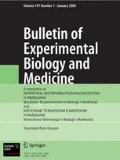The study analyzed the dynamics of intraperitoneal body temperature in C57BL/6 mice during 39 days of uninterrupted measurements. When mice were exposed to constant illumination, the ultradian oscillations of body temperature demonstrated the rhythms with periods of 2 h, 60 min, and 12 min, which were the higher harmonics of the circadian temperature oscillations. In two mutually isolated groups exposed to constant illumination, the phases of revealed biorhythms coincided. When the mice maintained under natural illumination, the body temperature demonstrated the ultradian rhythms with the same periods, which indicated that constant illumination did not distort the parameters of ultradian biorhythms. Probably, there is an external biotropic factor with similar harmonic spectrum, which synchronizes these biorhythms.
Similar content being viewed by others
References
Antokhin AI, Zharkova NA, Zakharchenko AV, Romanov YA. Rhythms of cell division of different periodicity in small intestinal cryptic epithelium and their contribution to circadian rhythm formation. Bull. Exp. Biol. Med. 2012;152(4):486-488. https://doi.org/10.1007/s10517-012-1559-1
Brodsky VY. Circahoralian (Ultradian) metabolic rhythms. Biochemistry (Moscow). 2014;79(6):483-495.
Brodskii VY, Mal’chenko LA, Dubovaya TK, Konchenko DS, Zvezdina ND. Administration of dopamine to rats disorganizes the rhythm of protein synthesis in hepatocytes. Bull. Exp. Biol. Med. 2014;157(2):220-223. https://doi.org/10.1007/s10517-014-2529-6
Diatroptov ME. The influence of the lighting mode on the ultradian rhythm of testosterone level in the serum of male rabbits. Geofiz. Protsessy Biosfera. 2013;12(1):62-69. Russian.
Diatroptov ME, Diatroptova MA, Kosyreva AM, Dzhalilova DS, Mkhitarov VA, Mikhailova LP, Makarova OV. Ultradian Rhythms of Body Temperatures in Male Wistar Rats Maintained under Conditions of Constant Illumination. Bull. Exp. Biol. Med. 2019;167(6):735-739. https://doi.org/10.1007/s10517-019-04611-z
Zenchenko ТА, Medvedeva AA, Khorseva NI, Breus ТK. Synchronization of heart rate indices of human and geomagnetic field variations in the frequency range of 0.5-3.0 mHz. Geofiz. Protsessy Biosfera. 2013;12(4):73-84. Russian.
Martynyuk VS, Vladimirskii BM, Temur’yants NA. Biological rhythms and electromagnetic fields of the environment. Geofiz. Protsessy Biosfera. 2006;5(1):5-23. Russian.
Sukhorukov MV, Spivak AA. Spatial and temporal characteristics of the field of radon in connection with the tectonic structures. Uspekhi Sovremen. Estesvoznan. 2017;(1):94-99. Russian.
Blessing W, Ootsuka Y. Timing of activities of daily life is jaggy: How episodic ultradian changes in body and brain temperature are integrated into this process. Temperature (Austin). 2016;3(3):371-383.
Braulke LJ, Heldmaier G. Torpor and ultradian rhythms require an intact signalling of the sympathetic nervous system. Cryobiology. 2010;60(2):198-203.
Didyk LA, Bogdanov VB, Lysenko VA, Didyk NP, Gorgo YP, Dirckx JJ. The effects of slight pressure oscillations in the far infrasound frequency range on the pars flaccida in gerbil and rabbit ears. Int. J. Biometeorol. 2007;51(3):221-231.
Didyk LA, Gorgo YP, Dirckx JJ, Bogdanov VB, Buytaert JA, Lysenko VA, Didyk NP, Vershygora AV, Erygina VT. Atmospheric pressure fluctuations in the far infrasound range and emergency transport events coded as circulatory system diseases. Int. J. Biometeorol. 2008;52(7):553-561.
Goh GH, Maloney SK, Mark PJ, Blache D. Episodic ultradian events-ultradian rhythms. Biology (Basel). 2019;8(1). pii: E15. https://doi.org/10.3390/biology8010015
Prendergast BJ, Cisse YM, Cable EJ, Zucker I. Dissociation of ultradian and circadian phenotypes in female and male Siberian hamsters. J. Biol. Rhythms. 2012;27(4):287-298.
Waite EJ, McKenna M, Kershaw Y, Walker JJ, Cho K, Piggins HD, Lightman SL. Ultradian corticosterone secretion is maintained in the absence of circadian cues. Eur. J. Neurosci. 2012;36(8):3142-3150.
Author information
Authors and Affiliations
Corresponding author
Additional information
Translated from Byulleten’ Eksperimental’noi Biologii i Meditsiny, Vol. 169, No. 3, pp. 361-365, March, 2020
Rights and permissions
About this article
Cite this article
Diatroptov, M.E., Diatroptova, M.A., Aleksankina, V.V. et al. Ultradian Biorhythms of C57BL/6 Mice Body Temperature under Constant Illumination or during Natural Day-Night Cycle. Bull Exp Biol Med 169, 388–392 (2020). https://doi.org/10.1007/s10517-020-04893-8
Received:
Published:
Issue Date:
DOI: https://doi.org/10.1007/s10517-020-04893-8


